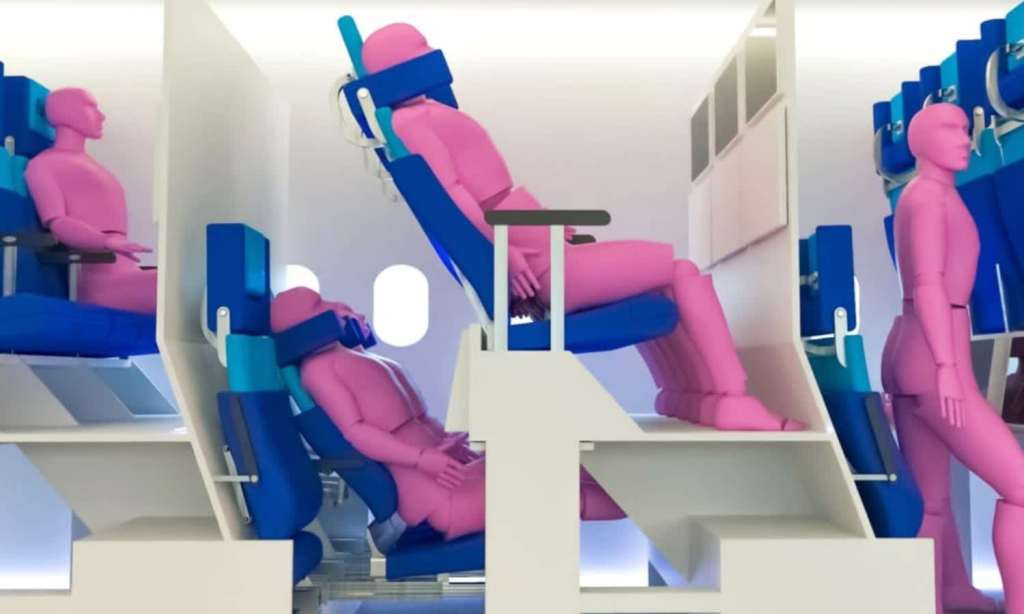Airplane designers have been conceptualising innovative economy cabins for many years, looking for an ideal balance of squeezing in as many passengers as possible, while keeping the experience enjoyable and spacious.
As you can imagine, it’s a quite a challenge. Economy air crafts are claustrophobic at the best of times!
But one new design, has captured the attention of design professionals and reddit-users alike; the dual level cabin.
Presented in the Judge’s Shortlist of the Crystal Cabin Awards, the dual level cabin operates on a somewhat double-decker seating model, with each row alternating between on-floor seating, and seats elevated a few meters above ground.
Designed by 21-year-old student Alejandro Núñez Vicente, originally from Spain but studying at TU Delft University in the Netherlands, this design successfully solves the ever present lack-of-leg room issue that already exists in current air crafts, while also creating space for more flyers.
The goal was to create a multi-level cabin experience that offered something appealing for travellers seated on both levels.
“The lower row has the advantage of passengers having the lounge experience of a couch by stretching the legs, whilst the upper row provides an SUV experience, making it possible for instance to cross the legs due to the increased leg room and overall living space,” Núñez Vicente says, in an article on CNN.
The seat design also offers more recline angles, and an adjustable back-rest and deployable neck-rest, to offer further comfort.
“The current economy class is often limited to a single or slightly reclined position that impedes the user from having a comfortable and relaxing flight experience,” says Núñez Vicente.
Although this clever design has many perks, the internet may not agree. People are worried about the uh, how do we put this… air quality?
Since articles emerging around the design concept of this dual level cabin have hit the internet, multiple reddit threads have been created, discussing the concerning potential of a passenger in the top section letting off gas, which thanks to the aircraft design, would land in their face.
I must admit the thought didn’t come to me straight away, but now, I can’t un-see it. The way that the dual seats are laid out, put the passenger in front of you’s butt, directly at nose-height. The thought of getting stuck behind someone’s butt, that can’t stop farting (especially if they’re smelly) during a flight actually sounds like a nightmare.
Now maybe this sounds snobbish because we all do farts, sometimes they stink and that’s okay. In any other situation, I’d probably say “get over it”. However, it’s actually scientifically known that people are more likely to produce gas on an airplane than down on the ground, so I actually think this concern is pretty reasonable.
Many travellers complain about feeling extra bloated and gassy on flights, and they’re not alone, there’s actually a scientific name for this scenario. It’s called HAFE, which stands for High Altitude Flatus Expulsion. Coined by a pair of researchers in the 1980s, this scientific yet tongue-in-cheek term describes a phenomenon observed when mountain climbers experienced flatulence at high altitudes. It can also happen while on board an airplane.
Plane cabins are pressurised between 6,000 and 8,000 feet, which is a pretty significant altitude. The gas in your intestines can actually expand at higher altitudes, which you’d find both atop a mountain and on a plane, sometimes growing to take up 30% more room than usual. Basically, to make more room again, alleviating discomfort, you don’t have much option but to fart.
To put it simply, people fart more on planes than you’d like to know.
Although we’re excited about new innovations in design and technology, and the thought of re-vamping the interiors of air crafts, we’re not entirely sure that we can get behind this dual level design with our newly discovered fart knowledge.
Read more stories from The Latch and subscribe to our email newsletter.







